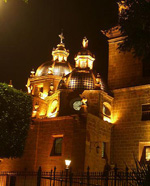
The Conference will take place in: CONVENTION CENTER
Built in the 16th century,
Morelia is an outstanding example of urban planning which combines the
ideas of the Spanish Renaissance with the Mesoamerican experience. Well-adapted
to the slopes of the hill site, its streets still follow the original
layout. More than 200 historic buildings, all in the region's characteristic
pink stone, reflect the town's architectural history, revealing a masterly
and eclectic blend of the medieval spirit with Renaissance, Baroque
and neoclassical elements.
Morelia is characterized by the magnificence of its monuments which are mostly colonial. The most remarkable buildings are the baroque cathedral, finished in 1744; the convent of San Francisco, built in 1513; the convent of San Agustín, founded in 1550; the college and temple of La Compañia de Jesus, started in 1580 and known as Palacio Clavijero; the convent of El Carmen, constructed in 1597; the convent of Santa Catarina that dates from the seventeenth and eighteenth centuries. Other important constructions are the 1613 convent of La Merced, the college of Santa Rosa María whose foundation was in 1743; the palace of the Executive, its construction started in 1734 and finished in 1770; the eighteenth century palaces of the Legislature and of the Judiciary; the sixteenth century college Primitivo y Nacional de San Nicolas de Hidalgo, reconstructed in 1882, the eighteenth century Museo Michoacano; and the house where José María Morelos was born, on Corregidora street, which is now used as a museum, library and for cultural events. The Casa de las Artesanías
features a large variety of high quality artisanal works. There are
several other notable historical churches in town including the Templo
de las Rosas annex to the Conservatorio de las Rosas, which are both
examples of baroque architecture, and the Templo de San Diego (also
known as Santuario de Guadalupe), built with an interpretation of the
Rococo style using indigenous colors and techniques.
©
World Association of Early
Childhood Educators (AMEI-WAECE)
on behalf Conference Programme Committee of the Second World Conference
on Early Childhood Education for Peace. Morelia-México. March,
5-7 2010.
|


 he
Historic Downtown Area (Centro Histórico), a UNESCO World Heritage
Site, encompasses approximately 150 city blocks at the city center,
roughly corresponding to the urban area of the city at the end of the
eighteenth century. The Centro Histórico contains over 1,000
historical buildings and sites.
he
Historic Downtown Area (Centro Histórico), a UNESCO World Heritage
Site, encompasses approximately 150 city blocks at the city center,
roughly corresponding to the urban area of the city at the end of the
eighteenth century. The Centro Histórico contains over 1,000
historical buildings and sites.